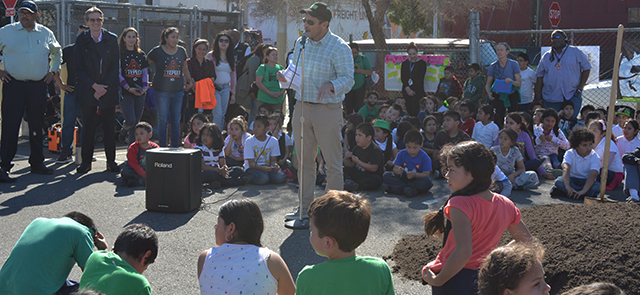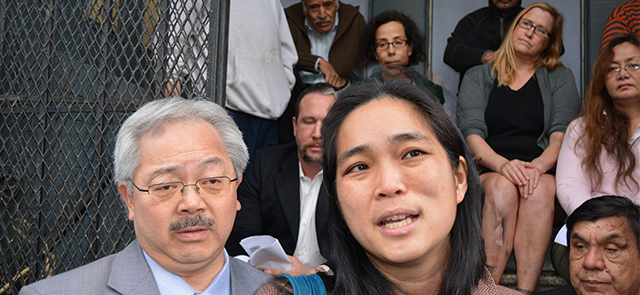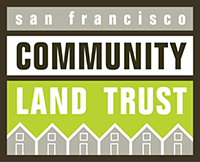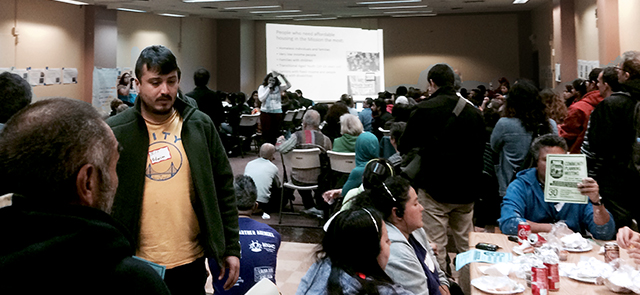Last night, hundreds gathered in the Mission Promise Neighborhood for the second community meeting on the Mission Action Plan 2020 (MAP 2020). The theme was “A Plan for and Community Discussion on Affordability, ” with the venue Buena Vista Horace Mann School on 23rd Street. A resource fair on tenants’ rights — and other issues of community importance — was part of the event presented by the City and County of San Francisco, Calle 24, the Cultural Action Network, Dolores Street Community Services, MEDA, Pacific Felt Factory and other community-based organizations.
The goal of MAP 2020 is to retain the socioeconomic and cultural diversity of the Mission neighborhood by providing solutions to help protect tenants at risk of eviction, increase affordable housing, stem the loss of social and community services offered to low- to moderate-income residents, and support and retain local businesses, including employers providing working-class jobs. The aim is to keep 65 percent of the Mission as low- or middle-income residents.
City officials on hand included District 9 Supervisor David Campos, Director of Mayor’s Office of Neighborhood Services Joaquin Torres and Jeff Buckley, who is senior advisor to Mayor Lee.
To welcome the attendees, City Planning Director John Rahaim took to the mic, explaining how San Francisco is trying to address the needs of Mission residents by being part of these community meetings.
Rahaim was followed by Director Antonio Aguilera at San Francisco Day Labor Programand Women’s Collective, who explained the need for the community’s voice to be heard.
Next up was Chirag Bhakta, of the Mission SRO Collaborative, who shared data from a PowerPoint. Bhakta’s dialog was peppered with these sobering facts: there were 989 eviction notices in the Mission from 2009 to 2014, with 1,174 Latinos compelled to leave the neighborhood between 2010 to 2013. He then explained that these numbers are probably conservative, as eviction numbers do not showcase buyouts and that undocumented people may be fearful of being part of a census.
Urban Planner Claudia Flores, from the San Francisco Planning Department, then continued on with the presentation. Flores spoke of the major accomplishments in the Mission community since the initial meeting one year ago. In that time, a set of community organizations and the City have been working to research and discuss the ideas collected, and implementing some immediate, short-term solutions.
There have been major wins, including:
- Pushing for neighborhood-preference legislation.
- Increasing resources for legal representation for tenants.
- Expediting 100 percent affordable sites (more than 300 units).
- Acquiring an additional affordable site at 490 South Van Ness.
- Dedicating funding of $50 million for the Mission from the Prop A housing bond that voters passed last November.
- Implementing higher scrutiny of market-rate projects through interim controls.
- Launching a nonprofit and creative-space displacement program, with $4.5 million in funding.
- Augmenting resources for PDR enforcement and technical assistance.
“We’ve already had some major victories in the past year, but there is much more to do. Mission Promise Neighborhood community input is vital to this process, so I am excited to see so many partners, city officials and neighbors here tonight,” stated MEDA’s Director of Community Real Estate Karoleen Feng.
Topics for discussion tonight ranged from how to preserve existing rent-controlled housing/SROs and increase job opportunities to stemming the loss of community-serving businesses and building more 100 percent affordable-housing developments. Attendees broke into groups, in English and Spanish, to discuss these weighty topics. The clear topic of interest was affordable housing — and how it could be funded. Community Engagement Manager Dairo Romero of MEDA acted as a facilitator for the Spanish-speaking tables.
The community’s valuable input will be discussed by organizations and the City, collaboratively working on solutions based on the ideas collected.
The final meeting will be in June, with the date and time to be determined.
____________________________________________________________
About Mission Promise Neighborhood
The Mission Promise Neighborhood is a citywide community partnership that was created to support kids and families living, working, and attending school in the Mission District. It brings together schools, colleges, community organizations and community leaders to help kids graduate and families achieve financial stability.









